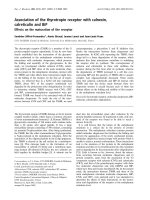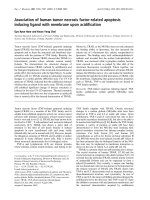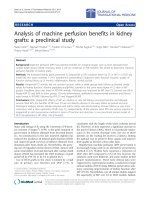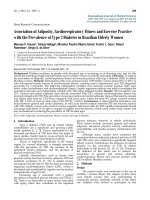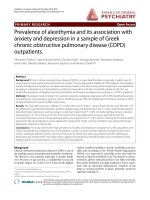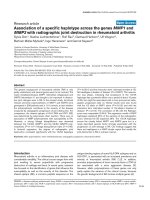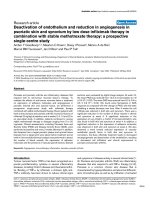Báo cáo y học: "Association of functional variants of PTPN22 and tp53 in psoriatic arthritis: a case-control study" docx
Bạn đang xem bản rút gọn của tài liệu. Xem và tải ngay bản đầy đủ của tài liệu tại đây (82 KB, 3 trang )
Open Access
Available online />Page 1 of 3
(page number not for citation purposes)
Vol 8 No 1
Research article
Association of functional variants of PTPN22 and tp53 in psoriatic
arthritis: a case-control study
Christopher Butt
1
, Lynette Peddle
1
, Celia Greenwood
2
, Sean Hamilton
1
, Dafna Gladman
3
and
Proton Rahman
1
1
Memorial University of Newfoundland, Hospital for Sick Children, Department of Public Health Sciences, University of Toronto, Toronto, Canada
2
Genetics and Genomic Biology, Hospital for Sick Children, Department of Public Health Sciences, University of Toronto, Toronto, Canada
3
University Health Network, Toronto Western Hospital, University of Toronto, Toronto, Canada
Corresponding author: Proton Rahman,
Received: 25 Jul 2005 Revisions requested: 18 Aug 2005 Revisions received: 25 Oct 2005 Accepted: 7 Dec 2005 Published: 3 Jan 2006
Arthritis Research & Therapy 2006, 8:R27 (doi:10.1186/ar1880)
This article is online at: />© 2006 Butt et al.; licensee BioMed Central Ltd.
This is an open access article distributed under the terms of the Creative Commons Attribution License ( />),
which permits unrestricted use, distribution, and reproduction in any medium, provided the original work is properly cited.
Abstract
Recent studies have implicated PTPN22 and tp53 in
susceptibility to several autoimmune diseases, including
rheumatoid arthritis, suggesting that these genes are important
in maintaining immune homeostasis. Because autoimmune
diseases may share similar susceptibility loci, investigation of
these genes in psoriatic arthritis (PsA) is of potential relevance.
As a result we investigated known coding polymorphisms in
PTPN22 and tp53 in a homogenous Caucasian PsA cohort
from Newfoundland, Canada and an admixed Caucasian PsA
cohort from Toronto, Canada. We observed a moderate
association of the R620W variant of PTPN22 with PsA in the
Toronto population only. Because of the conflicting findings
reported regarding the association of PTPN22 with PsA, further
studies in other PsA populations are warranted.
Introduction
Recently, two novel genes have attracted attention in the
investigation of autoimmune disease. The PTPN22 gene
encodes a functional protein tyrosine phosphatase known as
lymphoid phosphatase, which acts as a regulator of the nega-
tive regulatory kinase cytoplasmic tyrosine kinase in T cells,
and may play a role in suppressing T cell activation [1]. A func-
tional single nucleotide polymorphism (SNP) at nucleotide
position 1858, causing an Arg→Trp substitution (R620W)
that disrupts the binding site for cytoplasmic tyrosine kinase,
was recently found to be associated with type 1 (insulin
dependent) diabetes [2]. Subsequently, associations were
also found with other autoimmune diseases, including rheuma-
toid arthritis (RA) [3] and systemic lupus erythematosus [4] in
Caucasian populations. A large study in psoriasis involving
1,146 affected individuals [5] and a smaller study in psoriasis
in 265 families with multiple autoimmune diseases [6], with
only 63 psoriatics, revealed no association of the R620W var-
iant of PTPN22 with psoriasis.
The p53 protein has long been known to be related to the reg-
ulation of cell growth and prevention of carcinogenesis. It was
recently shown that tp53 is consistently underexpressed in
several autoimmune diseases, including RA, systemic lupus
erythematosus, multiple sclerosis and type 1 diabetes [7]. Fur-
thermore, the cellular damage response pathways that are
dependent on p53 are defective in patients with RA [8]. A
functional variant of p53 (Pro72Arg) has been shown to
induce apoptosis markedly better than the wild-type variant,
and has been associated juvenile chronic arthritis [9] but not
with adult-onset RA [10].
Although psoriasis and psoriatic arthritis (PsA) are interrelated
disorders, PsA is a distinct entity with its own epidemiological,
clinical and genetic features. Furthermore, PsA exhibits much
greater heritability among first-degree relatives (λ
1
48) than
does psoriasis (λ
1
5–10) [11]. Therefore, we set out to exam-
ine the association between these two high priority candidate
genes in two well characterized Caucasian PsA cohorts.
PCR = polymerase chain reaction; RA = rheumatoid arthritis; SNP = single nucleotide polymorphism.
Arthritis Research & Therapy Vol 8 No 1 Butt et al.
Page 2 of 3
(page number not for citation purposes)
Materials and methods
This study was approved by the local ethics committee of the
Memorial University of Newfoundland and University of
Toronto. Informed consent was obtained from all patients. All
PsA probands were Caucasians. Information was collected
systematically and included age at onset of psoriasis and PsA,
and disease pattern. The control individuals (controls) were of
similar ethnicity to the patients (cases). Controls for the New-
foundland population were volunteers from Newfoundland
who participated in our study as a result of a local campaign
seeking population-based controls for genetic studies. The
Toronto controls were ascertained from the local HLA labora-
tory DNA bank, which includes healthy volunteers and organ
donors.
Whole blood samples were obtained from PsA probands and
control individuals. DNA was extracted using the Promega
Wizard Genomic DNA purification Kit (Promega Corporation,
Madison, WI, USA). Detection of SNPs was performed by
analyzing primer extension products generated from previ-
ously amplified genomic DNA using a Sequenom chip-based
MALDI-TOF mass spectrometry platform (Sequenom Inc., San
Diego, CA, USA). In brief, polymerase chain reaction and
extension reactions were designed using MassARRAY design
software (Sequenom Inc.) and were carried out using 2.5 ng
template DNA. Unincorporated nucleotides in the polymerase
chain reaction product were deactivated using shrimp alkaline
phosphatase. The amplification of the SNP site was carried
out using the MassExtend primer and involved the use of spe-
cific d/ddNTP termination mixes, which were also determined
using MassARRAY assay design software. The primer exten-
sion products were then cleaned and spotted onto a Spectro-
Chip (Sequenom Inc.). The chips were scanned using a MT
Analyzer (Bruker Daltonics Inc., Billerica, MA, USA) and the
resulting spectra were analyzed and genotypes were deter-
mined using the Sequenom SpectroTYPER-RT software. We
genotyped PsA probands and control individuals for the fol-
lowing polymorphisms: PPTN22 (rs2476601, R620W) and
tp53 (rs1042522, Pro72Arg).
To determine differences in allele and genotyping frequencies,
2 × 2 contingency tables were used. Power calculations were
performed by simulating cases and controls assuming a multi-
plicative model for disease risk, and varying the genetic risk
associated with each copy of the high-risk variant. Observed
allele frequencies among controls were used to generate gen-
otypes, together with an assumed baseline risk for PsA of
between 0.005 and 0.01. For each candidate gene, 100 sim-
ulated data sets were created, the trend test was performed,
and we counted the number of simulations in which the P
value was less than 0.05.
Results
A total of 238 Newfoundland PsA patients and 149 healthy
Newfoundland control individuals were studied. With respect
to the Newfoundland PsA patients, 53% were male and their
mean age at onset of the study was 49.7 years. The mean age
at onset of psoriasis was 29.3 years (standard deviation 14.2
years) and the mean age at onset of PsA was 38.1 years
(standard deviation 11.0 years). Of the PsA patients, 60% had
polyarticular disease, 32% had oligoarticular disease and 7%
had an isolated spondyloarthropathy. For the Toronto popula-
tion, 207 PsA patients and 203 control individuals from the
Toronto population were genotyped. With respect to Toronto
PsA patients, 61% were male and their mean age at the start
of the study was 39.6 years (standard deviation 11.3 years).
The mean age at onset of psoriasis was 26.8 years (standard
deviation 12.1 years) and the mean age at onset of PsA was
33.0 years (standard deviation 10.8 years). Forty-four per cent
of the PsA patients had polyarticular disease, 40% had oli-
goarticular disease and 2.9% had isolated spondyloarthritis.
Of the 238 PsA patients genotyped for the R620W variant of
PTPN22 in the Newfoundland cohort, the C/C, C/T and T/T
genotypes for cases were 191, 44 and 3, respectively. For the
149 controls, the C/C, C/T and T/T genotypes were 121, 25
and 3, respectively. There was no difference in the minor allele
(T) frequency between cases (10.5%) and controls (10.4%)
for this PTPN22 variant (P = 0.96).
A total of 207 PsA patients and 199 control individuals were
genotyped in the Toronto population for the R620W variant of
PTPN22. For the PsA patients the G/G, G/A and A/A geno-
types were 153, 43 and 7, respectively, whereas for the
Toronto control individuals they were shown to be 167, 30 and
2. The minor allele (T) exhibited a frequency of 13.8% in PsA
patients versus 8.5% in control individuals. This was statisti-
cally significant when tested for the minor T allele (P = 0.018)
and for a trend in the genotypes (P = 0.024). Rheumatoid fac-
tor positivity was identified in 9% and 10% of the Newfound-
land and Toronto cohorts, respectively. No association was
associated with rheumatoid factor positivity and the minor (T)
allele for the PTPN22 variant in either population.
With respect to Pro72Arg variant of tp53, 207 PsA patients
were genotyped for the tp53 variant, and the G/G, G/C and
C/C genotypes for PsA patients were 119, 87 and 11, respec-
tively. For the 148 control individuals the G/G, G/C and C/C
genotypes were 78, 60 and 10, respectively. There was no dif-
ference in the minor allele (C) frequency for this tp53 variant
for cases (25.1%) and controls (27.0%; P = 0.56). The
Toronto cohorts were genotyped for the tp53 variant in 205
PsA patients, resulting in 116 G/G, 76 G/C, and 13 C/C gen-
otypes. With respect to the Toronto control individuals, 111
G/G, 76 G/C and 16 C/C genotypes were noted. The minor
allele frequency of the Pro72Arg tp53 gene variant in cases
and controls was 24.9% versus 26.6% (P = 0.57).
All control genotypes were in Hardy-Weinberg equilibrium.
Using the minor allele frequency of 0.10, observed among the
Available online />Page 3 of 3
(page number not for citation purposes)
controls for the PTPN22 gene, the study had more than 85%
power to detect a genotype relative risk of 2.0 or greater at
PTPN22, and a power near 0.67 to detect a genotype relative
risk of 1.75. At the tp53 gene, in which the minor allele fre-
quency among controls was higher (0.27), the power esti-
mates were near 0.75 for a genotype relative risk of 1.5, and
0.95 for genotype relative risks of 1.75.
Discussion
This is the first study to assess the association of the high pri-
ority candidate genes PTPN22 and tp53 specifically in PsA.
With respect to the R620W variant of PTPN22 in the New-
foundland population, our results are consistent with the
reported studies in psoriasis [5,6]. However, a modest associ-
ation was noted between this PPTN22 variant and PsA in the
Toronto cohort. Because the Toronto cohort is the first popu-
lation to report a significant association between PTPN22 and
PsA and contradicts previous larger studies in psoriasis [5,6],
this result should be interpreted with caution until it is inde-
pendently validated in another PsA population. It is conceiva-
ble that a true association exists and that this association is
disease (PsA) and population (Toronto) specific. It is worth-
while noting that the lymphoid-specific phosphatase encoded
by PTPN22 is among the most powerful inhibitors of T cell
activation, and so there is a potential rationale for this associ-
ation. Alternatively, a false-positive association may have
occurred in the Toronto PsA cohort because of population
stratification. Because the reported RA associations with
PTPN22 are almost exclusively with seropositive RA
[3,6,9,10], we stratified our population based on seropositivity
for rheumatoid factor, and found no association with PTPN22.
Over-expression and functional mutations of p53 have been
noted in synovial tissues of RA [12] and in cutaneous lesions
of psoriasis [13]. Because PsA shares pathogenic mecha-
nisms with RA and psoriasis, Salvador and coworkers [14]
examined p53 protein expression in synovial tissue of patients
with RA and PsA. They reported differential p53 expression in
the synovium of patients with RA as compared with PsA syn-
ovium. PsA patients had much less protein expression. This
suggests a different pathogenic mechanism in PsA as com-
pared with RA, and our study lends further support to this con-
tention because no association with tp53 was noted in either
of our PsA cohorts.
Conclusion
In this study we investigated the association of PTPN22 in two
independent PsA cohorts and obtained conflicting results. A
moderate association was noted in a well characterized,
admixed PsA cohort from Toronto, but this was not validated
in a homogenous Caucasian cohort from Newfoundland.
Therefore, further studies in additional PsA populations are
warranted to determine more definitively the role of PPTN22 in
PsA. No associations were observed with tp53 in either pop-
ulation.
Competing interests
The authors declare that they have no competing interests.
Authors' contributions
CB carried out molecular genetic studies, participated in study
design, and drafted the initial manuscript. LP assisted in gen-
otyping some of the control individuals. SH aided in recruit-
ment and clinical phenotyping of PsA patients. PR and DG
conceived the study, participated in its design and coordina-
tion, and helped to draft the manuscript. CG performed the
statistical analysis and revised the manuscript. All authors read
and approved the final manuscript.
References
1. Hasegawa K, Martin F, Huang G, Tumas D, Diehl L, Chan AC:
PEST domain-enriched tyrosine phosphatase (PEP) regula-
tion of effector/memory T cells. Science 2004, 303:685-689.
2. Bottini N, Musumeci L, Alonso A, Rahmouni S, Nika K, Rostam-
khani M, MacMurray J, Meloni GF, Lucarelli P, Pellecchia M, et al.:
A functional variant of lymphoid tyrosine phosphatase is asso-
ciated with type I diabetes. Nat Genet 2004, 36:337-338.
3. Begovich AB, Carlton VE, Honigberg LA, Schrodi SJ, Chokkalin-
gam AP, Alexander HC, Ardlie KG, Huang Q, Smith AM, Spoerke
JM, et al.: A missense single-nucleotide polymorphism in a
gene encoding a protein tyrosine phosphatase (PTPN22) is
associated with rheumatoid arthritis. Am J Hum Genet 2004,
75:330-337.
4. Kyogoku C, Langefeld CD, Ortmann WA, Lee A, Selby S, Carlton
VE, Chang M, Ramos P, Baechler EC, Batliwalla FM, et al.:
Genetic association of the R620W polymorphism of protein
tyrosine phosphatase PTPN22 with human SLE. Am J Hum
Genet 2004, 75:504-507.
5. Nistor I, Nair RP, Stuart P, Hiremagalore R, Thompson RA, Jenisch
S, Weichenthal M, Abecasis GR, Qin ZS, Christophers E, et al.:
Protein tyrosine phosphatase gene PTPN22 polymorphism in
psoriasis: lack of evidence for association. J Invest Dermatol
2005, 125:395-396.
6. Criswell LA, Pfeiffer KA, Lum RF, Gonzales B, Novitzke J, Kern M,
Moser KL, Begovich AB, Carlton VE, Li W, et al.: Analysis of fam-
ilies in the Multiple Autoimmune Disease Genetics Consor-
tium (MADGC) collection: the PTPN22 620W allele associates
with multiple autoimmune phenotypes. Am J Hum Genet
2005, 76:561-571.
7. Olsen NJ, Moore JH, Aune TM: Gene expression signatures for
autoimmune disease in peripheral blood mononuclear cells.
Arthritis Res Ther 2004, 6:120-128.
8. Maas K, Westfall M, Pietenpol J, Olsen NJ, Aune T: Reduced p53
in peripheral blood mononuclear cells from patients with rheu-
matoid arthritis is associated with loss of radiation-induced
apoptosis. Arthritis Rheum 2005, 52:1047-1057.
9. Taubert H, Thamm B, Meye A, Bartel F, Rost AK, Heidenreich D,
John V, Brandt J, Bache M, Wurl P, et al.: The p53 status in juve-
nile chronic arthritis and rheumatoid arthritis. Clin Exp Immu-
nol 2000, 122:264-269.
10. Lee YH, Kim YR, Ji JD, Sohn J, Song GG: p53 codon 72 polymor-
phism and rheumatoid arthritis. J Rheumatol 2001,
28:2392-2394.
11. Rahman P, Elder JT: Genetic epidemiology of psoriasis and
psoriatic arthritis. Ann Rheum Dis 2005:ii37-ii39.
12. Firestein GS, Nguyen K, Aupperle KR, Yeo M, Boyle D, Zvaifler NJ:
Apoptosis in rheumatoid arthritis: p53 overexpression in rheu-
matoid arthritis synovium. Am J Pathol 1996, 149:2143-2151.
13. Hannuksela-Svahn A, Paakko P, Autio P, Reunala T, Karvonen J,
Vahakangas K: Expression of p53 protein before and after
PUVA treatment in psoriasis. Acta Derm Venereol 1999,
79:195-199.
14. Salvador G, Sanmarti R, Garcia-Peiro A, Rodriguez-Cros JR,
Munoz-Gomez J, Canete JD: p53 expression in rheumatoid and
psoriatic arthritis synovial tissue and association with joint
damage. Ann Rheum Dis 2005, 64:183-187.
